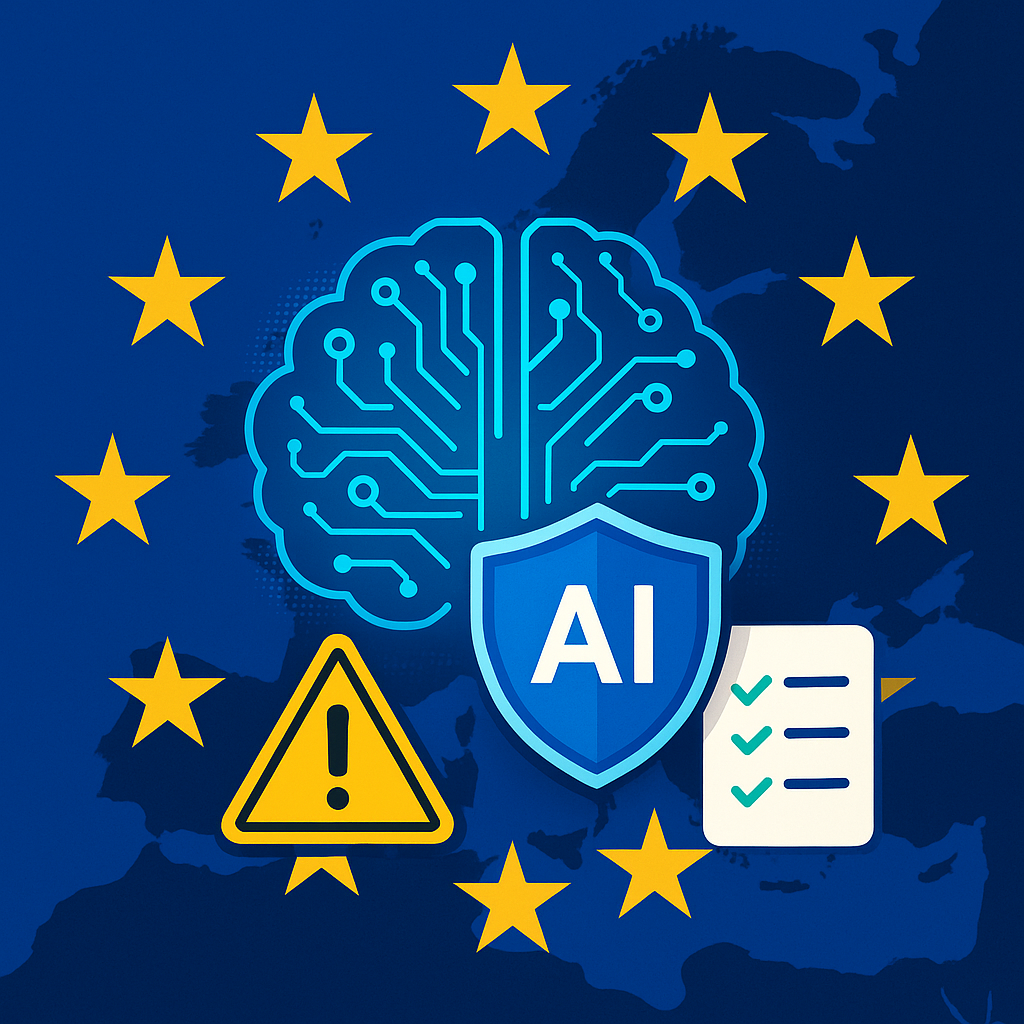AI News Today: EU's AI Act Compliance, US Ed Focus on AI Literacy, and xAI's "Baby Grok"

EU Issues Strict Guidelines for High-Risk AI: A Compliance Countdown
The clock is ticking for AI developers in Europe as the EU unveils stringent guidelines for high-risk AI systems, setting the stage for a compliance countdown. These new rules represent a significant shift in the AI landscape, demanding immediate action from companies operating within the EU.

European Commission's GPAI Guidelines
The European Commission has officially released its detailed guidelines for general-purpose AI (GPAI) systems that are deemed to carry systemic risk. This move underscores the EU's commitment to ensuring AI technologies are developed and deployed responsibly. Systemic risk, in this context, refers to the potential for an AI system to cause widespread disruption or harm across various sectors, making these guidelines paramount for maintaining stability and public trust. The guidelines cover a broad spectrum of AI applications, from those used in finance and healthcare to those powering critical infrastructure.
Mandatory Measures for AI Compliance
These aren't mere suggestions; they're mandates. The new guidelines spell out a series of rigorous requirements for developers of high-risk GPAI systems. These measures are designed to ensure that AI models are thoroughly evaluated, resilient against attacks, and transparent in their operations. Key requirements include:
Mandatory Model Evaluations: AI models must undergo continuous evaluation to identify and mitigate potential risks. This includes assessing their performance across various tasks and datasets.
Adversarial Testing: AI systems need to be tested against adversarial attacks to ensure they can withstand malicious attempts to manipulate or compromise their functionality. This is similar to penetration testing for software, but specifically tailored to AI models.
Incident Reporting: A clear process for reporting incidents related to AI system failures or unintended consequences must be established. This allows for rapid response and prevents further harm.
Cybersecurity Measures: Robust cybersecurity measures are essential to protect AI systems from unauthorized access and cyber threats. This includes implementing strong authentication mechanisms and data encryption.
These measures will require AI developers to invest heavily in testing, security, and monitoring capabilities. Companies like DeepMind, known for its groundbreaking work in AI, will need to adhere to these standards. Smaller companies may find the compliance process especially challenging.
The Price of Non-Compliance: Hefty Fines
The EU isn't playing around. The consequences for failing to comply with these regulations are severe. Companies found in violation of the AI Act can face fines of up to €35 million or 7% of their global turnover, whichever is higher. This substantial financial penalty underscores the seriousness with which the EU views AI regulation. Imagine a global tech giant like Google or Microsoft facing a fine of that magnitude – it's a clear incentive for companies to prioritize compliance.
The Compliance Deadline: August 2nd
Adding to the pressure is the looming compliance deadline. The EU AI Act, including these GPAI guidelines, takes effect on August 2nd. This leaves companies with a rapidly shrinking window to implement the necessary changes and ensure their AI systems are fully compliant. Think of it as a high-stakes race against time. For AI developers, August 2nd isn't just another date on the calendar; it's the day they either meet the new standards or risk facing significant penalties. This date coincides with the AI Act taking effect, solidifying the EU's commitment to AI regulation. Stay up-to-date with the latest developments in AI news to navigate this evolving landscape.

A Step-by-Step Roadmap for Frontier AI
Navigating the complexities of the EU AI Act requires a strategic approach. The European Commission provides a step-by-step compliance roadmap, specifically tailored for frontier AI models. This roadmap offers a structured framework, guiding developers through the necessary stages of assessment, mitigation, and ongoing monitoring. It's like having a detailed instruction manual for building AI systems that meet the EU's stringent standards. Here's what a comprehensive roadmap typically entails:
Gap Analysis: Evaluate existing AI systems to identify areas of non-compliance.
Risk Assessment: Conduct a thorough risk assessment to pinpoint potential systemic risks.
Implementation of Safeguards: Implement the mandatory measures, including model evaluations, adversarial testing, incident reporting, and cybersecurity measures.
Documentation and Transparency: Maintain detailed documentation of all compliance efforts.
Continuous Monitoring: Establish ongoing monitoring processes to ensure sustained compliance.
The EU's commitment to GPAI regulation marks a pivotal moment in the AI landscape. While the compliance deadline may seem daunting, the roadmap offers a clear path forward. By embracing these guidelines, companies can not only avoid hefty fines but also contribute to a safer, more responsible AI ecosystem. As the industry prepares for this new era, the need for proactive compliance and continuous adaptation has never been greater. The focus on systemic risk AI models highlights the importance of robust evaluation frameworks.
US Education Department to Prioritize AI Literacy in Education Grants
Imagine a future where every student not only knows how to use AI, but also understands its ethical implications – that's precisely the vision the U.S. Education Department is striving for.
A National Push for AI Fluency
In a move signaling the growing importance of artificial intelligence, the U.S. Education Department has proposed prioritizing AI literacy within its grant programs. This initiative aims to ensure that students and educators alike are equipped with the knowledge and skills necessary to navigate an AI-driven world. This isn't just about learning how to use the latest AI tools; it's about fostering a deeper understanding of the technology's potential and pitfalls.
Funding the Future of AI Education
The core of this proposal lies in directing federal funding towards initiatives that promote AI literacy. This includes a focus on:
AI Literacy Programs: Supporting the development and implementation of educational programs designed to enhance understanding of AI concepts, technologies, and applications.
Ethics Training: Providing resources for educators to integrate ethical considerations into AI-related curricula, ensuring responsible development and deployment of AI.
Responsible AI Classroom Use: Encouraging the thoughtful and ethical integration of AI tools and technologies within the classroom environment, fostering a culture of responsible innovation. Think of it as teaching students not just how to use ChatGPT, a popular AI chatbot known for its ability to generate human-like text, but when and why it's appropriate.
Seeking Public Input
Recognizing the importance of a collaborative approach, the Education Department is actively seeking public feedback on this initiative. This allows educators, students, parents, and industry experts to contribute their insights and perspectives, shaping the future of AI education in the United States.
Building a Workforce Ready for AI
The ultimate goal is to cultivate a workforce that is not only fluent in using AI tools but also deeply understands the ethical considerations surrounding their use. This means ensuring that future professionals are equipped to:
Utilize AI effectively: Applying AI technologies to solve complex problems and drive innovation across various industries.
Understand Ethical Implications: Recognizing and addressing the ethical dilemmas that may arise from the development and deployment of AI systems.
Promote Responsible AI: Championing the responsible and ethical use of AI to create a more equitable and sustainable future.
Supporting Ed-Tech Innovation
This initiative also includes federal support for ed-tech innovators who are developing cutting-edge AI literacy resources. This could mean funding for platforms that teach prompt engineering skills, such as those covered in our Prompt Engineering learning section, or backing projects that explore AI's impact through the AI Explorer.
By investing in AI literacy, ethics training, and responsible AI use in classrooms, the U.S. Education Department is paving the way for a future where AI is a force for good, empowering individuals and communities alike.
Ultimately, this move by the U.S. Education Department represents a crucial step towards ensuring that the next generation is well-prepared for the opportunities and challenges presented by artificial intelligence, and you can follow updates and more on the AI News page.
xAI Unveils "Baby Grok": A Child-Safe AI Chatbot
Imagine a world where your child can explore the wonders of AI in a safe and educational environment. That's the vision behind xAI's "Baby Grok," a new AI chatbot specifically designed for children.
Introducing Baby Grok: xAI's Foray into Child-Safe AI
Elon Musk’s xAI, the company behind the Grok AI model, is venturing into new territory with the development of "Baby Grok." This isn't just another AI chatbot; it's a carefully crafted experience tailored for young minds. Unlike its more mature counterpart, Grok, Baby Grok will feature filtered language and curated educational content, ensuring a safe and enriching interaction for children. This strategic move signals xAI's commitment to responsible AI development and broadening its appeal to a wider audience.
Features Designed for Safety and Education
Baby Grok isn't just about limiting exposure to harmful content; it's also about fostering a positive learning environment. Key features include:
Filtered Language: Advanced algorithms will detect and block inappropriate language, ensuring conversations remain age-appropriate.
Curated Educational Content: Baby Grok will provide access to a wealth of educational resources, making learning fun and interactive. Think of it as a digital tutor and playmate rolled into one.
Safety-First Design: Rigorous testing and safety protocols will be implemented to prevent unintended biases or harmful suggestions.

Softening xAI's Image and Entering the Family Market
This move is also a strategic play to soften xAI’s image, particularly after some controversies surrounding its unfiltered approach to content. By introducing Baby Grok, xAI aims to demonstrate its commitment to responsible AI development and build trust with parents and educators. This positions xAI to tap into the burgeoning market for family-market AI agents, where safety and educational value are paramount.
The Rise of AI Agents with Rigorous Safety Filters
Baby Grok represents a growing trend: the development of AI agents with rigorous safety filters. As AI becomes more integrated into our lives, the demand for safe and reliable AI tools for children will only increase. Companies are now racing to develop AI solutions that prioritize safety without sacrificing functionality. These filters are crucial for protecting children from inappropriate content, harmful interactions, and potential biases that can be present in AI models.
The Future of AI Chatbots for Children
AI chatbots for children are poised to revolutionize education and entertainment. Imagine a world where every child has access to a personalized AI tutor, a creative writing partner, or a virtual explorer guiding them through history and science. While there are challenges to overcome, such as data privacy and algorithmic bias, the potential benefits are immense. Grok, which is another product of xAI, can answer questions with a bit of humor and a rebellious streak, whereas Baby Grok will be tailored to be a more friendly and educational tool.
Baby Grok represents an exciting step forward in the development of child-friendly AI, highlighting the potential for AI to be a force for good in the lives of young people. The focus on safety and education could pave the way for more responsible AI development and integration into various aspects of our lives.
YUAN High-Tech Launches "Pandora" Edge-AI Box for On-Premise Inference
In a move highlighting the growing trend of edge computing, YUAN High-Tech has unveiled "Pandora," a new edge-AI box designed for on-premise AI inference.
Pandora: Bringing AI Inference Closer to the Source
The "Pandora" Edge-AI Box represents a significant step towards decentralized AI processing. Instead of relying solely on cloud-based computation, Pandora brings the power of AI directly to where it's needed. This is particularly crucial for applications that demand real-time responsiveness and cannot tolerate the latency associated with sending data to and from remote servers.
At its core, the Pandora Edge-AI Box is powered by the NVIDIA Jetson Orin NX. This System on Module (SOM) delivers impressive performance and energy efficiency, making it ideal for demanding AI workloads in various environments. The NVIDIA Jetson Orin NX provides a compact and powerful platform, enabling Pandora to execute complex AI models with speed and precision.
Targeted Applications: Smart Retail, Robotics, and Education
YUAN High-Tech is positioning Pandora for deployments across several key sectors. Consider these use cases:
Smart Retail: Imagine AI-powered inventory management, enhanced security through facial recognition, and personalized customer experiences – all processed locally for faster response times.
Robotics: Edge AI enables robots to make real-time decisions without constant cloud communication, essential for tasks like autonomous navigation and object recognition in dynamic environments.
Classrooms: In educational settings, Pandora can facilitate AI-driven learning tools, providing instant feedback and personalized tutoring, even when internet connectivity is limited or unreliable.
The Rise of On-Premise, Low-Latency Inference
The Pandora Edge-AI Box underscores a growing shift from cloud-first to hybrid AI architectures. While cloud computing remains essential for training large AI models and managing vast datasets, edge AI addresses the need for real-time inference and data privacy. By processing data locally, Pandora minimizes latency, reduces bandwidth consumption, and enhances data security – critical factors for many applications.
The move towards edge AI reflects a maturing AI landscape, where organizations seek to optimize performance, cost, and security by strategically distributing AI workloads across cloud and edge resources.
Understanding Edge AI
Edge AI refers to the deployment and execution of AI algorithms on devices physically located near the data source. These "edge devices" can range from specialized hardware like the Pandora Edge-AI Box to smartphones and embedded systems. The primary advantage of edge AI is its ability to perform inference (i.e., making predictions or decisions based on trained models) with minimal latency, which is crucial for real-time applications.
This strategic shift towards hybrid architectures represents a significant evolution in how we leverage AI, creating opportunities for innovation across diverse industries. As AI continues to permeate various aspects of our lives, expect to see more specialized hardware solutions emerge, catering to the unique demands of edge computing.
CIOs Embrace Agentic AI: 93% Building Custom Solutions
CIOs aren't just talking about AI; they're actively building it, especially when it comes to agentic AI. A recent OutSystems survey has revealed a staggering 93% of CIOs are currently building custom AI agents to address specific business needs.
The Rise of Custom AI Agents
This isn't just theoretical exploration; it's a full-blown embrace of practical AI solutions. These custom AI agents are designed to act as digital employees, handling tasks autonomously and learning from experience. It’s like giving each department its own super-powered, AI-driven intern, tailored to their unique workflows. Think of it as moving beyond off-the-shelf solutions to create AI that truly understands your business.
The survey underscores a significant shift: businesses are recognizing that generic AI solutions often fall short and are turning to custom-built agents for a competitive edge.
Agentic AI in Production: No Longer Just a Pilot Project
The survey also highlights how rapidly agentic AI is moving from the lab to the real world. According to the data, 47% of respondents already have agentic AI deployed in production applications, meaning these AI agents are actively contributing to core business processes. An additional 28% are in the pilot phase, testing and refining their AI agent strategies. This demonstrates that agentic AI isn't just a future concept; it's a present-day reality for many organizations.
Top Use Cases: Customer Support, Product Development, and More
So, where are these AI agents making the biggest impact? The survey points to several key areas:
Customer Support: Imagine AI agents instantly resolving customer queries, freeing up human agents for complex issues. This can dramatically improve customer satisfaction and reduce support costs. A tool like Intercom, a customer messaging platform that leverages AI to automate support and personalize interactions, is already helping businesses achieve this.
Product Development: AI agents are helping to analyze market trends, identify customer needs, and even generate new product ideas. It's like having a dedicated team of AI-powered researchers working around the clock. Perhaps teams are leveraging DeepMind AlphaFold, an AI system that predicts protein structures, to accelerate drug discovery.
Sales and Marketing: From lead generation to personalized email campaigns, AI agents are automating and optimizing sales and marketing processes. Think of AI as a tireless marketing assistant, constantly refining campaigns and identifying new opportunities. For example, you can use HubSpot Email Writer, which helps create engaging and effective marketing emails with the power of AI.
Governance and Security: The Elephant in the Room
Despite the enthusiasm for agentic AI, CIOs aren't ignoring the potential risks. The survey reveals that governance and security remain top hurdles for adoption. Ensuring that AI agents operate ethically, comply with regulations, and protect sensitive data is a major concern. Robust AI governance frameworks and advanced security measures are crucial for mitigating these risks.

Integration of "Digital Teammates"
Ultimately, the goal is to seamlessly integrate AI agents into the workforce as "digital teammates." This requires careful planning, effective communication, and a focus on collaboration between humans and AI. It's about augmenting human capabilities, not replacing them entirely. The rise of agentic AI marks a significant step towards a future where AI is an integral part of every organization. Keeping up with the latest in the field through sources like AI News is extremely important.
As agentic AI becomes more prevalent, expect to see increased focus on ethical considerations, security protocols, and the development of tools to manage and monitor AI agent behavior. This is a rapidly evolving field, and the next few years will be critical in shaping the future of AI in the workplace.
GPT-5 Leak Reveals "Dynamic Routing" for Specialized AI Tasks
Just when we thought the AI landscape couldn't get any more intriguing, a leak has surfaced, hinting at groundbreaking advancements in GPT-5, OpenAI's highly anticipated next-generation AI model. Let's dive into what this leak suggests and what it could mean for the future of AI.
Dynamic Routing: The Key to GPT-5's Power?
The most significant revelation from the leak is the potential implementation of "dynamic routing." Imagine a super-intelligent air traffic controller, but instead of planes, it's managing different specialized AI sub-models. This dynamic routing system would allow GPT-5 to intelligently invoke specific sub-models tailored for particular tasks. It's like having a team of experts on call, each specializing in a different area, and GPT-5 knows exactly who to call upon for each unique challenge.
This approach contrasts with the monolithic architecture of previous models. Instead of a single, all-encompassing model trying to handle everything, GPT-5 could leverage a modular system for increased efficiency and expertise.
Demonstrated International Math Olympiad–Level Reasoning
Beyond the architectural changes, the leak also suggests a significant leap in reasoning capabilities. GPT-5 has reportedly demonstrated the ability to solve problems at the level of the International Math Olympiad. This isn't just about crunching numbers; it's about understanding complex mathematical concepts and applying them creatively to solve novel problems. If true, this would mark a substantial improvement over previous models and showcase the potential for AI to tackle sophisticated intellectual challenges.
GPT-6: Already on the Horizon?
While GPT-5 is still shrouded in mystery, the leak also dropped a tantalizing hint about the future: GPT-6 is reportedly already in early training. This suggests that OpenAI is not resting on its laurels and is continuously pushing the boundaries of AI capabilities. It's a reminder that the field of AI is constantly evolving, and what seems like science fiction today could be reality tomorrow.
Model Scaling and Specialization: The Future of AI Architectures
The concepts of model scaling and specialization are central to understanding these advancements. Model scaling refers to increasing the size and complexity of AI models, typically by adding more parameters (the variables the model learns during training). However, simply scaling up a model doesn't always lead to better performance. That's where specialization comes in.
By creating specialized sub-models and dynamically routing tasks to them, GPT-5 could achieve a level of efficiency and expertise that would be impossible with a single, monolithic model. This modular approach is likely to become increasingly important as AI models continue to grow in size and complexity.
Modular, Efficient AI Architectures: A Paradigm Shift
The move towards modular, efficient AI architectures represents a significant paradigm shift in the field. Instead of building ever-larger models, the focus is shifting towards creating more intelligent and adaptable systems. This approach has several potential benefits:
Improved Efficiency: By only invoking the necessary sub-models, the system can conserve computational resources and reduce energy consumption.
Enhanced Expertise: Specialized sub-models can be trained on specific tasks, allowing them to develop a deeper understanding of their respective domains.
Increased Adaptability: The modular architecture makes it easier to update and improve individual sub-models without affecting the entire system.
Dynamic routing and specialized sub-models could be a game-changer, leading to more efficient, adaptable, and intelligent AI systems.
These leaks about GPT-5's architecture and the early training of GPT-6 highlight the rapid pace of innovation in AI. The industry is moving towards more modular and efficient architectures that can tackle increasingly complex tasks. As AI continues to evolve, it's crucial to stay informed about these advancements and their potential implications. Next, let's delve into the US educational system's increasing focus on AI literacy and how it could shape the future workforce.
Lovable Raises $200M, Becomes Europe's Newest AI Unicorn
The European AI landscape just got a major boost with Lovable closing a massive $200 million Series A funding round, catapulting the company to a staggering $1.8 billion valuation and making it Europe's newest AI unicorn. This isn't just another funding announcement; it signals a significant shift in how AI is developed and deployed. Lovable's approach is focused on empowering everyone to harness the power of AI, regardless of their technical expertise.
Democratizing AI Development
Lovable is pioneering a no-code agentic AI platform, essentially handing the keys to AI development to a much wider audience. Think of it as the Squarespace or Wix of AI—instead of wrestling with complex code, users can visually design and deploy sophisticated AI agents.
No-code Interface: The platform's intuitive drag-and-drop interface allows users to create custom AI agents without writing a single line of code.
Agentic AI: Lovable specializes in agentic AI, where AI agents can autonomously perform tasks and make decisions, automating complex workflows.
Orchestration Capabilities: Users can easily orchestrate these AI agents, creating complex workflows and automating entire business processes.
This approach is a game-changer because it bypasses the traditional bottleneck of needing specialized AI engineers. Now, subject matter experts, business analysts, and even citizen developers can build AI-powered solutions tailored to their specific needs. Lovable envisions a world where citizen developers are empowered to deploy autonomous agents, transforming how businesses operate and innovate. This is a huge step towards democratized AI development, allowing smaller companies to use AI where they wouldn't have been able to before.
The Power of No-Code AI
Lovable's success underscores the growing demand for accessible AI development tools. The platform's no-code nature is especially appealing in today's environment, where many companies are struggling to find and retain AI talent. With no-code AI platforms, businesses can unlock the potential of AI using their existing workforce. It's not about replacing developers, it’s about augmenting their capabilities and enabling non-technical staff to contribute to AI initiatives.
"Lovable's vision is to empower everyone to become an AI creator. We want to make AI development as easy as building a website or creating a presentation." - Lovable AI Founder
Agentic AI Funding: A Sign of the Times
Lovable's massive funding round isn't just about the company itself; it's a reflection of broader trends in the AI industry. Investors are increasingly interested in agentic AI funding, recognizing the potential of AI agents to automate complex tasks and transform industries. This funding reflects the growing confidence in the transformative potential of autonomous AI systems. These AI agents can be used in fields from customer service to supply chain management, and represent an exciting area of growth within the broader AI ecosystem. You can stay on top of trends like this by regularly reading our AI News section.
Lovable's Series A round is a testament to the company's innovative approach and the growing demand for accessible AI development tools. By empowering citizen developers to build and deploy custom AI agents, Lovable is poised to revolutionize how businesses leverage the power of AI. This represents a pivotal moment in the evolution of AI, moving it from the realm of specialized experts to the hands of everyday users.
🎧 Listen to the Podcast
Hear us discuss this topic in more detail on our latest podcast episode: https://open.spotify.com/episode/4k6tvgYryF3C5mCGdEiwfs?si=HS7bVrfyTRGNZavjVUwPWw
Keywords: AI, Artificial Intelligence, AI Governance, Agentic AI, Edge AI, AI Literacy, EU AI Act, GPT-5, xAI, AI Chatbots for Children, Systemic Risk AI Models, AI in Education, AI Investment, AI Development Platforms
Hashtags: #AI #AIGovernance #EdgeAI #AgenticAI #AILiteracy
For more AI insights and tool reviews, visit our website https://best-ai-tools.org, and follow us on our social media channels!
Website: https://best-ai-tools.org
X (Twitter): https://x.com/bitautor36935
Instagram: https://www.instagram.com/bestaitoolsorg
Telegram: https://t.me/BestAIToolsCommunity
Medium: https://medium.com/@bitautor.de
Spotify: https://creators.spotify.com/pod/profile/bestaitools
Facebook: https://www.facebook.com/profile.php?id=61577063078524
YouTube: https://www.youtube.com/@BitAutor
Recommended AI tools

Navigating the ethical landscape of AI

Bridging Islam and Artificial Intelligence

Empowering Ethical AI


